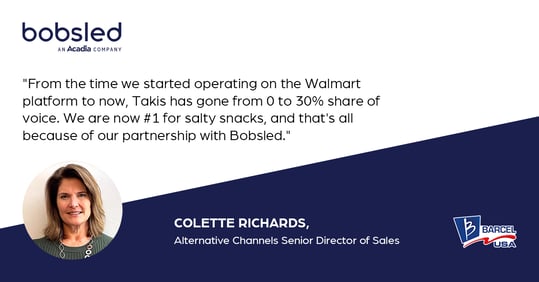According to Statista, in 2020 over 2 billion people purchased products online, with e-tail sales surpassing over $4.2 trillion worldwide. The below screenshot exemplifies the steady growth of ecommerce, and how projected sales are expected to be in excess of $6 trillion by the year 2024.
Above: Image from Statista
 What is driving such staggering growth? According to statistics from Oberlo, convenience is the top reason why customers choose to shop online. Therefore, it’s crucial for your brand to appraise the various ecommerce platforms and put together a robust omnichannel playbook.
What is driving such staggering growth? According to statistics from Oberlo, convenience is the top reason why customers choose to shop online. Therefore, it’s crucial for your brand to appraise the various ecommerce platforms and put together a robust omnichannel playbook.
In today’s blog post, Bobsled’s Nikhil Chothani has shared a high-level overview and playbook for Amazon, Walmart, Instacart, and DTC.
Amazon
Amazon! The head-honcho of all ecommerce platforms, and the largest e-tailer in the world. The ‘King of E-commerce generated over $386B in revenue in 2020, and as ecommerce is still relatively new for a vast number of consumers, things are only just starting to get interesting.
Here are things brands should be considering as they factor Amazon into their online playbook.
- Amazon’s sheer size is perhaps the main reason why you should be selling your product on the platform. The consumer base and market share is so large, that once you have a foothold within the global marketplace, you can instantly reach millions of loyal Amazon shoppers worldwide! Learn more – How To Become An International Seller On Amazon
- Although Amazon has millions of active sellers across various categories, it’s relatively simple for new brands to create a Seller account and list their products. Due to the highly competitive nature of the marketplace, the real challenge is cutting through the noise and getting shoppers to buy your products.
- There are several operational and advertising levers that can be pulled to get your product in front of shoppers. Amazon PPC advertising is perhaps the most essential tool that can boost your presence. However, you need to spend efficiently to preserve profit margins on the channel. Learn more – How much should I spend on Amazon PPC?
- Once you have hit the point of diminishing returns with your PPC efforts, brands need to start implementing retargeting display ads via Amazon DSP. DSP is incredibly useful because it helps boost brand awareness and sales. Learn more – Amazon DSP Retargeting - The First 30 Days
- Certain products on Amazon perform extremely well, whereas others produce underwhelming results due to profitability or market demand issues. While launching new products to diversify your Amazon catalog is good in theory, it’s crucial to;
- Launch products that cater to consumer demand
- Ensure you can turn a profit on each new SKU after Amazon fees and advertising costs have been accounted for
- As per Jungle Scout, the top-selling categories on Amazon are as follows:
It’s important to get a good understanding of the potential of each new product prior to launching. Bobsled helps brands by completing competitive market research. We not only look at competitors, but pricing, sales, ratings, reviews, and more to help our clients make the right decision across any product category. Learn more – Amazon Account Launch
- When it comes to profit margin, specific categories on Amazon are tougher than others. For example, water brands typically have slim margins. A water brand selling a one-liter six-pack for $17.49 USD walks away with an approximately 37% margin (this does not include the cost of goods). Therefore, if you want to sell products on Amazon, try and select SKUs that fall within a category that has a higher margin opportunity.
- Although it may be relatively pain-free to set up your Amazon accounts, as soon as you start selling, you will be hit with a variety of fees. Referral fees, LTSF fees, and FBA fees are a few that immediately spring to mind, and quite often Amazon will overcharge you for no rhyme or reason. It’s crucial that you keep track of all Amazon fees and learn how to effectively dispute erroneous charges. Learn more – The Complete Guide to FBA Fees
Walmart
Here are things brands should be considering as they factor Walmart into their online playbook.
- Walmart is a distant second to Amazon when it comes to marketplace size. Traffic estimates vary, but Walmart generates roughly 135M monthly visits vs 1B+ monthly visits with Amazon. Therefore, brands should have realistic expectations in terms of revenue opportunity (approximately 5 to 10% of Amazon revenue for most brands selling on both channels).
- Walmart allows customers to shop online or see products that are PUT (Pick Up Today) in-store. Approximately 90% of the US population lives within 10 miles of a Walmart store, meaning PUT provides Walmart real differentiation in the ecommerce space.
- There are two inventory fulfillment options – Fulfilled By Merchant (FBM) or Walmart Fulfillment Services (WFS).
1) FBM. Whether a brand uses a third-party logistics provider or fulfills directly from their own warehouse, Walmart views both as FBM. Bobsled suggests finding a 3rd party logistics partner who can deliver within a 2-day window to take advantage of the 2-day shipping badge which is the equivalent of Amazon’s Prime badge.
2) WFS. WFS looks to mirror Amazon’s FBA offerings and fees will be within 5-10% of FBA fees for most brands. However, even though it was rolled out to the public in early 2020, WFS was somewhat halted by Covid according to the director of the program.
- The PPC advertising structure is similar to Amazon but far less advanced. Walmart currently uses a ‘1st price’ bidding model compared to Amazon’s ‘2nd price’ model. With Walmart’s ‘1st Price’ model, if you bid $3, and the nearest competitor only bids $2, you will still pay $3
- There are unfortunately many limitations with seller tools and Walmart at this point in time. For example, a buyer message console was only unveiled late this year, and the marketplace has been around for almost 5 years! Brands need to feel comfortable with uncertainty (or work directly with a qualified partner) if they wish to enter the Walmart marketplace. However, Walmart is moving in the right direction though with the updates we’ve seen this year with the Listing Quality Dashboard, Seller Hub, and Message Console.
- Walmart is generally suited to medium and larger brands that can view entry to the marketplace as a long-term investment. Brands that appeal to the typical “Walmart customer” should be the first in line to appraise the Walmart online marketplace. Strong brick-and-mortar sales within Walmart stores would be a strong indication of this synergy.
💡 Check out How To Sell On Walmart
Learn how How Barcel USA, Maker of Takis, Increased Sales on Walmart.com by 113x with Bobsled
Instacart
Instacart enjoyed a rapid ascension in 2020, especially during the early phases of Covid. Why is Instacart important to your omnichannel strategy and how does it differ from other marketplaces?
- Instacart is a grocery delivery and pick-up service. Customers order groceries from participating retailers, and orders are assembled by personal shoppers. Inventory only comes from retailers, never from brands directly. Learn more – An Introduction To Instacart For Brands
- Therefore, retailers are key stakeholders. They are responsible for inventory availability, pricing, and product content. This puts brands in an unusual position as they cannot directly control their presence on the channel.
- Instacart’s vast network of retailers is their USP; it provides Instacart with an unparalleled product assortment that not even Amazon can rival.
- Online Grocery got a massive bump in 2020 due to Covid, and this essentially tripled Instacart’s size almost overnight. In June 2020 Instacart owned 46% of all grocery delivery sales!
Above: Image from Second Measure
- Instacart has traditionally had a tough time building relationships with brands. Connectivity issues arise because of where sales show up (retailer partners) and confusion surrounding where Instacart should fit into a brand’s P&L. Learn more – How To Sell On Instacart: Your Internal Team
- Instacart is a great way to expand your sales if your product is in the grocery or CPG space, as Instacart recently expanded its reach into Beauty, Baby and Pet Supplies through partnerships with Best Buy, Walmart, Staples, Bed Bath & Beyond, Buy Buy Baby, Sephora, and 7-11 among others.
- With retailers like Walmart becoming a greater player in grocery delivery services, it is good to note that although Instacart has a unique offering, they do not enjoy a monopoly in the space. The big players are doing their absolute best to win back market share with services like Walmart Grocery and Amazon Fresh. Learn more – Amazon Fresh Predictions
💡 Want to learn more about Instacart?
We wrote the book! Check out Instacart for CMOs
DTC
And finally, even the most marketplace-loyal of brands are starting to realize the value of incorporating a functioning DTC channel into their omnichannel strategy!
- The main benefit of a DTC (Direct-to-Consumer) website is that brands can foster direct relationships with customers. This is different from major marketplaces, which limit the amount of customer data brands can access.
- A core DTC challenge, especially for small-to-medium-sized companies, is building up enough trust with consumers to complete a transaction through a DTC website vs a tried and tested online marketplace such as Amazon.

- Influencer marketing is a common way brand tackle the trust issue. Influencers can be very effective because they generally have built up a lot of goodwill with their audience. Influencers can send traffic wherever you wish, but many brands opt for DTC because they can achieve better per order profit margins on their own website versus marketplaces such as Amazon and Walmart. Learn more – Working With Influencers
- This article highlights some of the following advantages of using DTC:
- Direct ownership of the customer relationship.
- Access to shopper data from ecommerce reporting.
- Direct ownership of the customer lifecycle.
- Ability to offer customers exclusive products and marketing offers.
- Increase in brand profitability through the removal of retailer costs.
- Test and range more products.
- Brands typically rely on Google and Facebook advertising to drive traffic to DTC websites. Interestingly, brands can now harness Amazon DSP customer data to send qualified traffic too. Learn more – Use Amazon DSP To Direct Shoppers To Your DTC Website
 On October 19th at 11 am EST, Bobsled Founder & CEO Kiri Masters will be hosting a very insightful webinar about 7 of the most important challenges ecommerce & digital leaders of omnichannel brands will face in the coming year.
On October 19th at 11 am EST, Bobsled Founder & CEO Kiri Masters will be hosting a very insightful webinar about 7 of the most important challenges ecommerce & digital leaders of omnichannel brands will face in the coming year.
REGISTER NOW TO SECURE A FREE SPOT
Get The Mix Right For Your Brand’s Goals
As per nChannel, “87% of shoppers begin product searches on digital channels... Even if they end up buying from a physical store, shoppers are more likely to start their search online…”
Therefore, it’s safe to say having a robust online presence will impact every aspect of your business moving forward. Understanding the pros and cons of Amazon, Walmart, Instacart, DTC and any other major channels will inform how to get the mix right for your brand.

Tagged: PPC Advertising, Amazon Account Management, Walmart, Instacart
.png)

